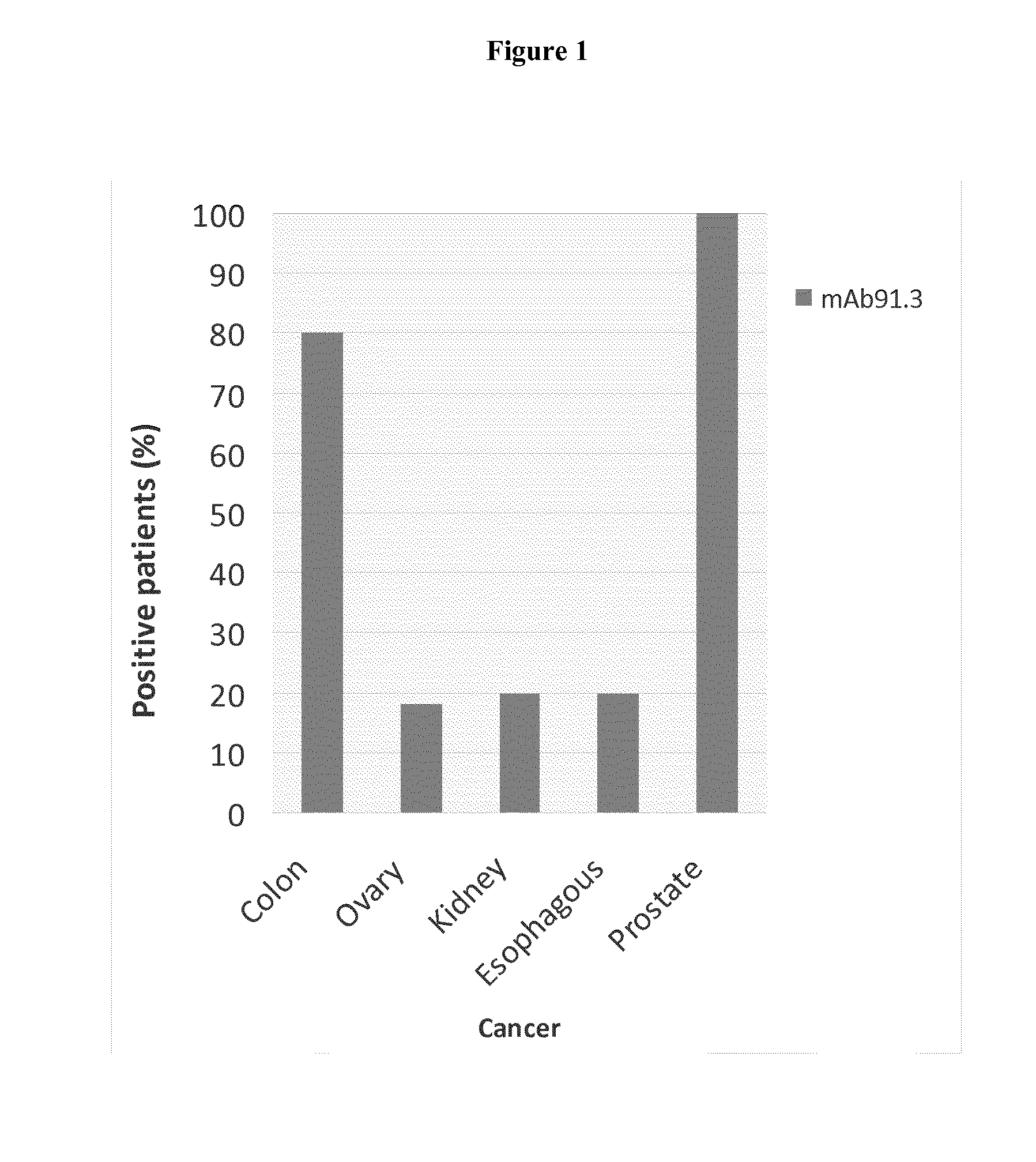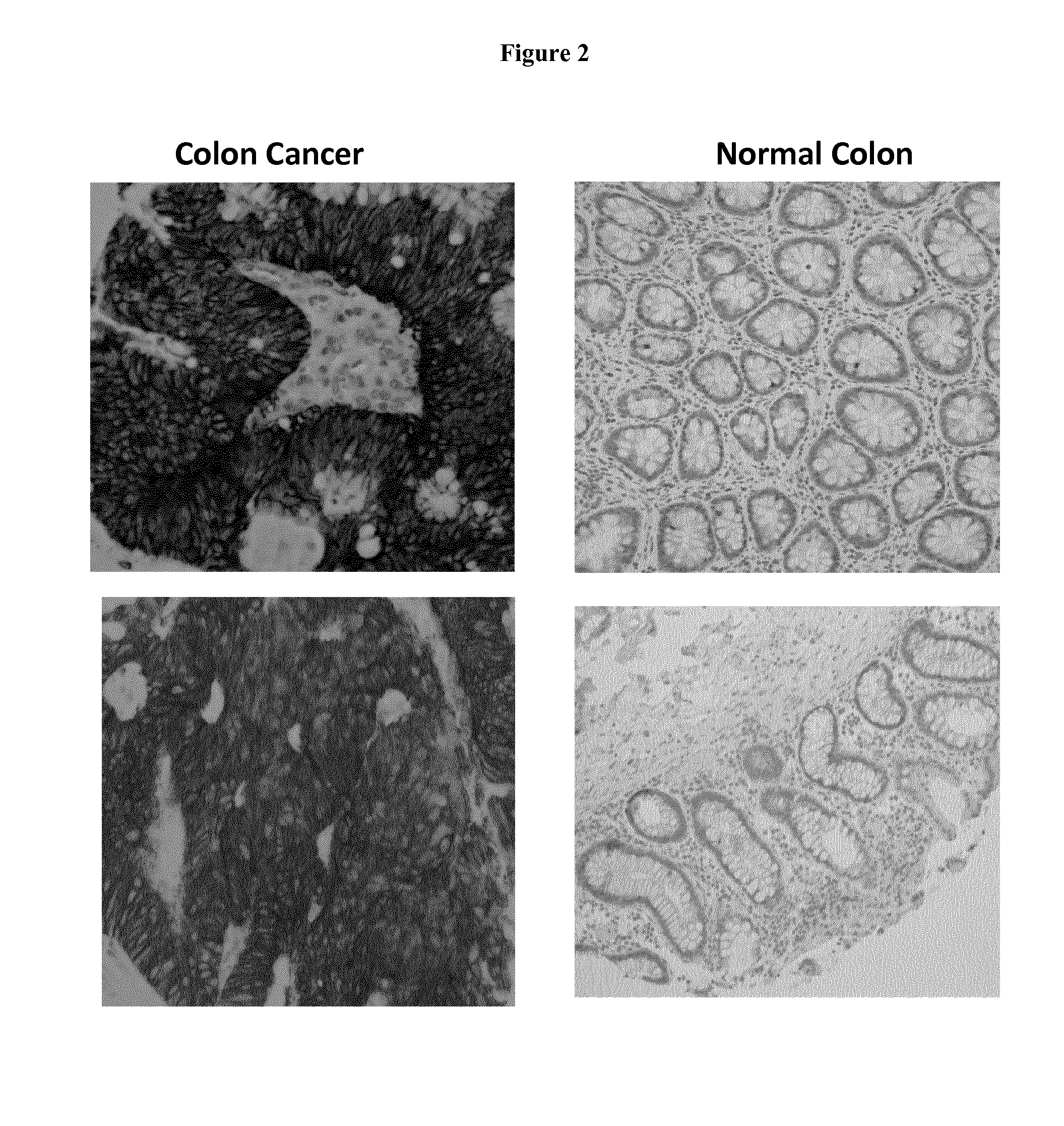Tumor marker, monoclonal antibodies and methods of use thereof
a monoclonal antibody and tumor marker technology, applied in the field of tumor markers and monoclonal antibodies, can solve the problems of loss of the ability to regulate b-catenin, and achieve the effects of reducing cancer growth, reducing cancer growth, and facilitating internalization
- Summary
- Abstract
- Description
- Claims
- Application Information
AI Technical Summary
Benefits of technology
Problems solved by technology
Method used
Image
Examples
example 1
Discovery and Confirmation of FAT1 Over-Expression in Cancer by Immune-Histochemistry
[0098]A proprietary collection of polyclonal and monoclonal antibodies raised against human recombinant proteins was used to identify proteins over-expressed in cancer by immune-histochemistry (IHC). The antibody library was used screen clinical samples by Tissue Micro Array (TMA), a miniaturized immuno-histochemistry technology suitable for HTP analysis that allows to analyse the antibody immuno-reactivity simultaneously on different tissue samples immobilized on a microscope slide. Since the TMAs include both tumor and healthy tissues, the specificity of the antibodies for the tumors can be immediately appreciated. The use of this technology, differently from approaches based on transcription profile, has the important advantage of giving a first hand evaluation on the potential of the markers in clinics. Conversely, since mRNA levels not always correlate with protein levels (approx. 50% correlati...
example 2
Expression and Localization of FAT1 Protein in Cancer Cells
[0105]The expression and localization of FAT 1 protein in cancer cells was investigated using an anti-FAT1 monoclonal antibody to confirm that FAT1 is expressed by cancer cell lines derived from the human cancers found positive in the IHC screening. Moreover, FAT1 surface localization surface was verified to confirm that FAT1 could be exploited as therapeutic target of anti-cancer therapies. FAT-1 affinity ligands, such as small molecules or antibodies, able to recognize the protein on the cell surface can be developed as novel therapeutic antigens. Finally the association of FAT1 with cell-derived exosomes was investigated to assess whether FAT 1 is released by cancer cells and could be detected in patients' biological fluids. This property would allow developing non-invasive diagnostic assays based on FAT1 detection. Moreover, exosomes could be exploited in vaccines based on the elicitation of antibody and T cell response ...
example 3
Confirmation of the Specificity of the Anti-FAT1 Antibody by Gene Silencing
[0116]The specifity of the anti-FAT1 monoclonal antibody mAb91.3 showing selective cancer reactivity in IHC was further verified by specific FAT1 knock-down in FAT1 positive tumor cell lines by the siRNA technology and the knock-down of FAT1 expression was monitored at transcriptional and protein level.
Method
[0117]FAT1 expression was silenced in the HCT15 colon cell lines with two FAT1-specific siRNAs (10 nM) (whose target sequences are reported in the Table) using the HiPerfect transfection reagent (QIAGEN) following the manufacturer's protocol. As control, cells treated with equal concentrations of irrelevant siRNA (scrambled siRNA) were analysed in parallel. At different time points (ranging from 24 to 72 hours) post transfection, the reduction of gene transcription was assessed by quantitative RT-PCR (Q-RT-PCR) on total RNA, by evaluating the relative marker transcript level, using the beta-actin, GAPDH o...
PUM
| Property | Measurement | Unit |
|---|---|---|
| weight | aaaaa | aaaaa |
| weight | aaaaa | aaaaa |
| diameter | aaaaa | aaaaa |
Abstract
Description
Claims
Application Information
 Login to View More
Login to View More - R&D
- Intellectual Property
- Life Sciences
- Materials
- Tech Scout
- Unparalleled Data Quality
- Higher Quality Content
- 60% Fewer Hallucinations
Browse by: Latest US Patents, China's latest patents, Technical Efficacy Thesaurus, Application Domain, Technology Topic, Popular Technical Reports.
© 2025 PatSnap. All rights reserved.Legal|Privacy policy|Modern Slavery Act Transparency Statement|Sitemap|About US| Contact US: help@patsnap.com



